Content [show]
We have a special relationship with chrysanthemum, this is the flower that is always nice to remember! To get compact flowering bushes, garden chrysanthemums need to be well cared for, planted, watered and fed on time, properly shaped, divided and cuttings.
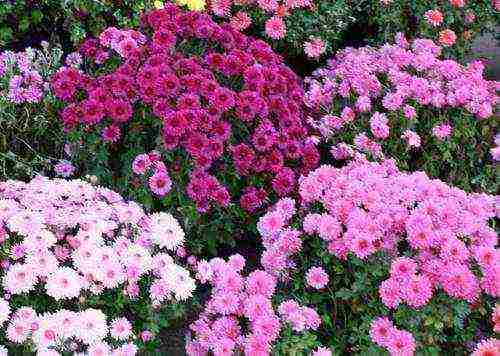
Features of growing perennial garden chrysanthemums (small-flowered), planting and care ...
Without going into the details of the classification, we will divide all chrysanthemums conditionally into two types:
- Large-flowered Indian, flowers that we often see in beautiful bouquets, they can be grown if you live somewhere in the southern regions, or you have a greenhouse or greenhouse.
- Shrub varieties, small-flowered, very beautiful and compact-looking chrysanthemums - we especially highlight the group of Korean hybrids (Chrysanthémum × koreanum), most often grown in the middle lane.
Most gardeners grow only cold-resistant chrysanthemums, which we used to call Korean (oak, oak). Their origin is hybrid, there are a lot of varieties and they are very diverse in color, size and shape. Chrysanthemum all season will delight, if not with flowers, then with its crown, foliage, a beautiful ball. And they bloom until late autumn, depending on the variety - 20-60 days.
Among small-flowered bush chrysanthemums, flowers can be double: flat, hemispherical, spherical, pompom, curly; as well as simple (chamomile): non-double, semi-double, anemone.
In terms of landscape design, chrysanthemum is a very interesting flowering plant. She is one of the first to appear in the spring, the flower itself, of course, blooms in the fall, but its foliage is small, so carved, slightly silvery in color, looks great in any color combinations, in harmony with many garden plants.
Can chrysanthemums be planted in autumn?
Most experts in this field believe that the autumn planting of perennial chrysanthemums should be carried out only in warm regions, giving preference for this to small-flowered varieties. In addition, this is the most common time when planting material is sold in the markets. Florists have the opportunity to evaluate the bush, its height, size and color of the inflorescences. If you buy chrysanthemums for planting in the spring, it remains to follow at random, since it is quite difficult to predict anything by looking at the still bare branches.
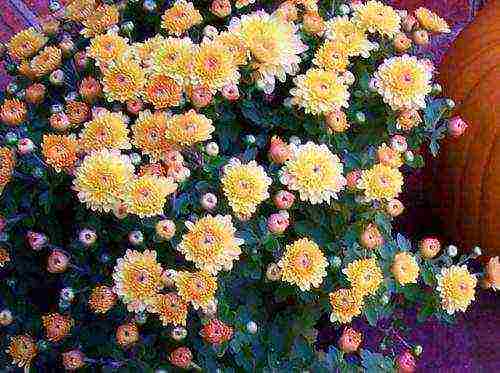
It is better to buy early flowering chrysanthemums no later than September, besides, the plant should be blooming profusely.
Flowering seedlings are typically sold by cut flower growers and late flowering varieties are often grown in their greenhouses to prolong flowering. The next fall, the chrysanthemum does not have time to bloom in our gardens, because of the frost, all the long-awaited beauty disappears.
A worthy option is to buy a flowering bush in a pot in the fall, wait until the end of flowering, break off the dry stems and leave for the winter in a dry, cold basement at a temperature of 4-5 degrees Celsius. In the spring, plant chrysanthemums in open ground. The conditions for proper winter storage are described below.
Some tips for planting chrysanthemums in the fall:
- The optimal time for planting is considered the end of September - the first half of October;
- You should not plant flowering bushes - there is a great risk that they will not take root;
- For planting, it is better to choose bushes on which root shoots have formed.
- Before the frost, the planted chrysanthemums must have time to get stronger in order to endure the winter frosts well.
- Do not forget to mulch the soil with a layer of peat or compost, and before frost in November, it is better to cover it with something to protect it from the cold.
Choosing a place for planting chrysanthemums.
First of all, it should be an open, well-ventilated and sunlit place. There should be no constant wind and draft, at the same time, there should be no stagnation of air.
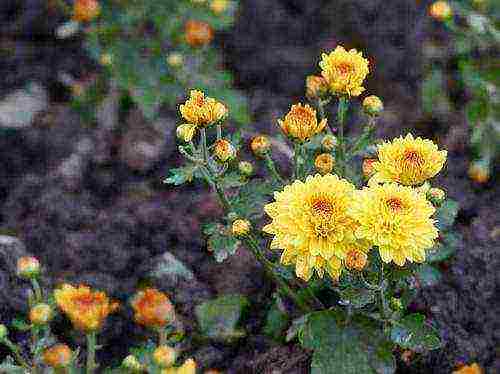
It should not be planted in lowlands so that the root system is not flooded with water. It is advisable to plant on small hillocks, so that in case of heavy rainfall, the water goes down and does not stagnate in the roots.
If you want to plant chrysanthemums in sandy soil, fill with good compost, humus, as it loves fertile soil. A bush on too fertile soil can grow to the detriment of flowering.
We will plant bush chrysanthemums ...
You have purchased neat bushes of small-flowered chrysanthemums in garden centers or from private owners, or they have already been growing in the garden for more than one year and need to be planted. You can simply divide the roots into parts and plant each one separately. The plant takes root well and you will have several bushes. Before digging up the bush, water it to saturate them with moisture.
We prepared the site in advance, divided it into grooves. The distance between the holes is small, almost close, so that between the bushes it turns out 35-40 cm, small border compact bushes can be planted denser - 20-25 cm. It is advisable to add some kind of organic fertilizer or compost to each hole. Since the roots of a young plant are still weak, mineral fertilizers are not poured into the planting hole, otherwise we risk "burning" the roots.
In early spring, 1 time in 3 years, multiple shoots should be planted. We dig out the whole mulched bush when the regrown shoots reach a height of 5-7 cm.
We take a bush, shake off the ground and begin to simply break it in half. Then we separate the neat well-developed sprouts with roots one by one. If a sprout is left without a root, then it can be rooted like a cutting in damp ground. The sprouts can be small, medium or large, depending on the parent shrub we choose to plant. Fill the holes with water and, like any seedlings, plant chrysanthemum plants.
How the bush is formed correctly ...
The pinching procedure is one of the important points in the care of garden chrysanthemums. If we pinch correctly, then a chic bush can turn out from a small sprout.
Before planting the root, in large sprouts with leaves in several tiers, pinch the top so that the plant has 5-6 true leaves, not counting the stepsons. By removing the growth point, we thus stimulate the development of lateral shoots of the second order.If this is not done, the sprout will grow upward, the stepsons will begin to appear, but not so powerful, the bush will not be so compact and not so abundant.
For curbs, re-pinching will not work, it will simply grow in such a round ball, and for those chrysanthemums that are taller, you will have to pinch again on second-order shoots, leaving 3-4 leaves.
Caring for chrysanthemum in the garden
Chrysanthemum is not a plant for the lazy and requires constant care, including planting. As already mentioned, the bush is regularly pinched to increase bushiness due to the growth of lateral shoots.
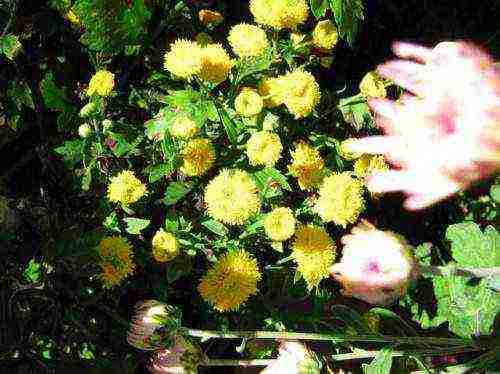
In June-July, be sure to water chrysanthemums abundantly, especially when the first buds appear. In no case do not sprinkle its crown, watering should be only under the root system. In August, watering can be stopped - the flowering period begins. Reacts well to a decrease in night temperature.
Top dressing is done in spring and summer, once every 2 weeks with mineral and organic fertilizers. At the beginning of growing young chrysanthemums, it is better to use nitrogen fertilizers to build up the green mass, later phosphorus-potassium fertilizers for better flowering.
Loosening is carried out only in the first month after planting, so as not to damage the root system and the root growth that is growing by the fall.
Cuttings are carried out in the open field, from the end of May to September. You can bend the branches to the ground and pin them with special wire forks, so they give roots very quickly.
In the fall, when you break off the stems, there are trimmings - cuttings already ready for planting. Better to plant in special substrates designed for rooting. Either they are dipped in water and they give roots - this is the most elementary way.
Wintering conditions for chrysanthemums in the middle lane ...
Some gardeners fear that small-flowered Korean chrysanthemums may freeze in winter. In principle, in some northern regions this happens, so in October, mulch the space under the bush, cover the root system with a thick layer of peat and compost. And already in November, not earlier, so that the plant does not become rotten, cover it on top with spruce branches left after pruning coniferous trees. It is a very good cold insulating material.
You can dig a chrysanthemum bush into some container, add earth and store it in a cold cellar. Do not forget to break off the dried stems. Digging with a shovel, you should retreat from the main stem further away, since the bush grows in a circle and gives offspring at a distance of up to 20 cm.Practice shows that chrysanthemums overwinter quite successfully at a temperature of 4-5 degrees, and in the spring they are again transferred to the ground.
You do not need to water them, otherwise the new shoots that form there will begin to grow ahead of time. Nothing good will come of this, the stems will only stretch out from a lack of light, and the roots will deplete. If the soil is too dry during storage, then you can put a couple of handfuls of snow on top of the soil, or lightly sprinkle it with a moisturizer.
In no case do not put a pot or a lump of earth in a bag, this will cause condensation to accumulate and the sprouts under the film will begin to rot.
After digging, a couple of shoots from this bush may remain in the ground, we leave them in place in the garden, fill the hole with soil, mulch, cover with something and see what happens, whether they overwinter or not. And then we will know how to deal with it next year. Is it worth digging them up later, or is it better to leave them for the winter in the ground.
If you bought chrysanthemums with large flowers, white or yellow, which are sold for cutting, they are most likely Indian large-flowered varieties. In our climate, they do not hibernate at all and simply do not have time to bloom, it is not even worth experimenting. Plant them in some container and also put them in the cellar.And then large-flowered garden species of chrysanthemums have their own subtleties in growing, which must be discussed separately.
 From the middle of summer until the very frost, many homesteads, summer cottages and front gardens are decorated with bright bushes of garden chrysanthemums. The plant blooms even when many flowers have already withered after the first frost. Even the most experienced gardeners are amazed at the variety of flower colors, types and shapes. You can learn about the varieties and characteristics of growing the "Queen of Autumn" by reading our article. And photos of chrysanthemums will help you choose the types of flowers suitable for the garden.
From the middle of summer until the very frost, many homesteads, summer cottages and front gardens are decorated with bright bushes of garden chrysanthemums. The plant blooms even when many flowers have already withered after the first frost. Even the most experienced gardeners are amazed at the variety of flower colors, types and shapes. You can learn about the varieties and characteristics of growing the "Queen of Autumn" by reading our article. And photos of chrysanthemums will help you choose the types of flowers suitable for the garden.
Varieties and varieties of garden chrysanthemums with photos
Garden chrysanthemum is a perennial plant whose height depends on the species and can be from 15 to 150 cm... Currently, a large number of varieties of chrysanthemums are known, which, according to some features and characteristics, are combined into groups.
The size of the inflorescences
Perennial chrysanthemums are divided into three groups according to the diameter of the flowers:
- small-flowered;
- mid-flowered;
- large-flowered.
Small-flowered or Korean plants can be simple and double. A large number of inflorescences grow on one bush with a flower diameter of 2-10 cm... The bushes themselves can reach a height of 25 to 120 cm. The leaves of the plant are in the form of oak leaves. Flowers are frost-resistant, undemanding to the composition of the soil and easy to care for. Their flowering begins in mid-September and continues until the very frost.
Mid-flowered or ornamental chrysanthemums can be grown not only for garden decoration, but also for cutting. They also grow well in pots at home. They can be used to decorate balconies, loggias and terraces. Ornamental shrubs grow up to 30-70 cm, and have a flower diameter of 10-18 cm.
Large-flowered chrysanthemums are spectacular tall plants. The length of their stem can reach from 80 to 120 cm. They bloom in large flowers with a diameter of 10-25 cm. This type of chrysanthemum does not tolerate frost well. Only some of its varieties can winter outdoors. Such flowers are intended mainly for cutting into bouquets.
The shape and height of the bush
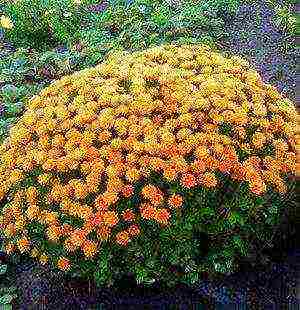 According to the shape and height of the bush, garden chrysanthemums are divided into three types, each of which has many varieties.
According to the shape and height of the bush, garden chrysanthemums are divided into three types, each of which has many varieties.
Tall. The stems of this type of garden chrysanthemum can be very tall and require supports such as frames, metal nets, or wooden pegs. Supports are installed during the planting of the bushes. Plants planted in a group can be used as a hedge. Most popular varieties tall garden chrysanthemums are:
- "Amber Lady" - the plant is distinguished by golden inflorescences.
- "Umka" - chrysanthemums with white flowers, the shape of which resembles a pompom.
- "Daughter of Rosetta" is strewn with flat inflorescences with flowers of pink and white shades.
Medium-sized. Bushes growing up to 30-50 cm look very impressive both on a flower bed and along paths, fences, arbors. With their help, you can realize various design fantasies. The best varieties of medium-sized garden chrysanthemums are considered:
- "Dawn" - the plant has a yellow-brown color, which is just right for the autumn mood.
- "Dune" is a truly magical variety, the flowers of which can change their color during flowering. They bloom yellow-brown, and after a few days they turn yellow-gold.
- "Lily" will help to add brightness to any composition with its dark crimson flowers.
Curb. Small plants grow up to only 30 cm. This type of chrysanthemum is considered one of the most beautiful garden flowers. Bushes of curb chrysanthemums have the shape of a ballcovered with small flowers. In this group, the most popular varieties:
- "Barbara" is a plant with delicate lilac-purple flowers.
- "Evening Lights" - the variety is distinguished by scarlet inflorescences that resemble a festive fireworks.
- "Talisman" is strewn with bright beetroot-crimson flowers.
Flower shape
Garden chrysanthemums have five different kinds of flower shapes:
-
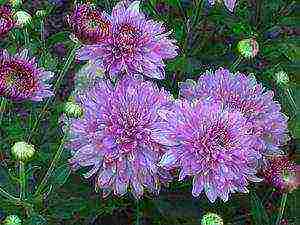 Pompom flowers are an assembly of tongues that are assembled into a ball that resembles a pompom.
Pompom flowers are an assembly of tongues that are assembled into a ball that resembles a pompom. - Anemoid flowers consist of large petals, which are collected in one, two or three rows. The flowers themselves are small in size and very similar to anemone flowers.
- Single-row and double-row inflorescences are bordered by flowers that look like tongues. In the center of such inflorescences, small tubular flowers grow. The border of flowers can be arranged in one or two rows.
- Semi-double flowers consist of three rows of reeds that are arranged around a central flower.
- Terry inflorescences are similar to semi-double ones, but their flowers are more luxuriant, since they are diverse in appearance and shape.
Garden chrysanthemums - planting and care
It is recommended to plant a plant during the period from late May to mid-June... Until autumn, the bushes will have time to take root and get stronger. And then they will not be afraid of any winter frosts.
Landing features
Chrysanthemums love sunny areas. The plant requires a lot of light to set flower buds. Even in partial shade, chrysanthemums will not bloom.
The soil must be rich in organic matter. Therefore, during digging, one bucket of manure, compost or peat must be added to one square meter of soil. You don't need to add more organic matter, otherwise only leaves will grow rapidly on the bush, and the plant will bloom with very small flowers.
When planting a garden chrysanthemum, it is recommended:
-
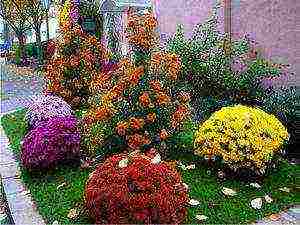 For large bushes, the distance between the holes should be at least 50 cm, and for small bushes - 25 cm.
For large bushes, the distance between the holes should be at least 50 cm, and for small bushes - 25 cm. - It is recommended to add drainage or sand to each hole.
- When planting, the plant cannot be deeply deepened into the ground.
- Near large, tall bushes, you must immediately install a support.
- The leaves of the plant can be sprayed with Epin to help it adapt better. "Kornevin" is also suitable, with a solution of which the bush is watered.
- If frosts are still expected, then the young bush should be covered with nonwoven material at night.
Care rules
When caring for a garden chrysanthemum, special attention should be paid to watering it, since the plant depends on soil moisture level... You need to water the bushes in a timely manner, otherwise the flower will throw off all the buds.
The amount of water for watering one bush depends on its characteristics. Plants with small, stiff leaves can be watered less frequently than plants with soft, large leaves that evaporate a lot of moisture.
Chrysanthemums respond well to feeding. For this, complex mineral fertilizers containing magnesium and potassium, and organic in the form of humates are used. During the active growth of green mass, the plant is fed with nitrogen.
Caring for garden chrysanthemums involves forming a bush. It is necessary regularly pinch and trim... For the first time, the top of the plant is removed when the central shoot grows to 10 cm. After a while, when the lateral shoots grow up to 10 cm, they also pinch the crown. After that, the bush grows to bloom.
During the period when the chrysanthemum blooms, faded and wilted buds should be regularly removed from its bush. This way the flowering period can be extended.
If you want to get big beautiful flowers, you can make a total pruning of side shoots. As a result, only one stalk and one peduncle will remain on the bush. All the forces of the plant will go to the formation and growth of the flower.
Winter garden chrysanthemum care
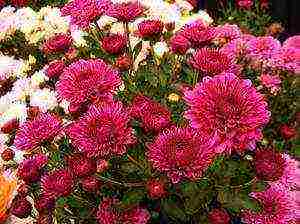 In order for a plant planted in the garden to bloom as beautifully and profusely next year, you need to make sure that it overwinters well.
In order for a plant planted in the garden to bloom as beautifully and profusely next year, you need to make sure that it overwinters well.
In frosty winters even cold-resistant varieties require shelter... Therefore, after the end of flowering, the stems of the bushes are cut to the ground. The plant hides and covers itself with fallen leaves.
Chrysanthemums with large flowers are afraid of freezing temperatures.Therefore, they need to be dug out together with an earthen lump and planted in a suitable container. Plants are stored before planting in the spring in a room with a temperature of 0-5 degrees. Caring for them consists in rarely watering an earthen coma, which should not dry out.
Diseases and pests of perennial chrysanthemums
With proper care, the plant is rarely affected by pests and practically does not get sick. However, the bushes need to be inspected regularly in order to identify the problem as soon as possible and begin to treat the plant. The threat to garden chrysanthemums is posed by:
- Spider mite is a pest that sucks juice from a plant. It can be found by the cobweb formations on the back of the sheet. If the leaves of a chrysanthemum become gray-brown, begin to darken and fall off, then, most likely, a tick has settled on it. The plant must be treated with special chemicals.
- Leaf nematodes - the disease is manifested by deformation of the leaves, and their darkening between the veins. In this case, you need to change the soil and cut off the damaged areas.
- Verticillosis is an infectious disease that spreads through the roots. Therefore, the leaves begin to turn yellow and wither from the bottom of the bush. In the initial stages, spraying with biological products will help.
- Powdery mildew first affects the leaves and buds, on which a white bloom appears. The affected parts of the plant are removed, and the bush itself is treated with Bordeaux liquid.
Reproduction of bush chrysanthemum
Chrysanthemum can propagate in three ways:
- dividing the bush;
- seeds;
- by cuttings.
Dividing the bush
The bushes can be divided in the spring, but only after the threat of frost has passed. In order for chrysanthemums to bloom better, it is recommended to divide their bushes every three years. To do this, the plant is carefully dug up and divided into several small bushes. The roots of the plant will need to be cut. Delenki are planted in the ground and watered.
Seed reproduction
In open ground sowing is done in May... For each future plant, a separate hole is dug, the distance between which should be 25 cm. 3-4 seeds are buried in one hole. For the first time, chrysanthemums should bloom at the end of summer.
Cuttings
 Propagation by cuttings is the easiest way, since chrysanthemums take root quickly and well.
Propagation by cuttings is the easiest way, since chrysanthemums take root quickly and well.
- A stalk with 3-4 leaves is cut under a leaf pattern. Its length should be 6-8 cm.
- The container is filled first with peat, and then with sand, into which the stalk sits.
- The soil is sprayed and the box is covered with glass.
The rooting temperature should be between 13-15 degrees. When the roots appear, the cuttings will need transplant into separate pots... Young bushes are planted in open ground only when frost has passed.
Observing the rules of planting and caring for garden chrysanthemums, you can achieve a beautiful and spectacular flowering during half of summer and almost all of autumn. Any part of the garden where the "Queen of Autumn" will grow will become a luxurious decoration of the garden.
Bush chrysanthemum
Rate the article:
(17 votes, average: 4.4 out of 5)
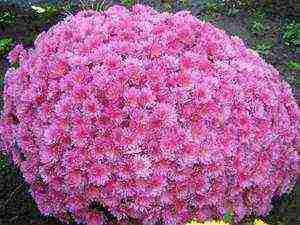 From the middle of summer until the very frost, many homesteads, summer cottages and front gardens are decorated with bright bushes of garden chrysanthemums. The plant blooms even when many flowers have already withered after the first frost. Even the most experienced gardeners are amazed at the variety of flower colors, types and shapes. You can learn about the varieties and characteristics of growing the "Queen of Autumn" by reading our article. And photos of chrysanthemums will help you choose the types of flowers suitable for the garden.
From the middle of summer until the very frost, many homesteads, summer cottages and front gardens are decorated with bright bushes of garden chrysanthemums. The plant blooms even when many flowers have already withered after the first frost. Even the most experienced gardeners are amazed at the variety of flower colors, types and shapes. You can learn about the varieties and characteristics of growing the "Queen of Autumn" by reading our article. And photos of chrysanthemums will help you choose the types of flowers suitable for the garden.
Varieties and varieties of garden chrysanthemums with photos
Garden chrysanthemum is a perennial plant whose height depends on the species and can be from 15 to 150 cm... Currently, a large number of varieties of chrysanthemums are known, which, according to some features and characteristics, are combined into groups.
The size of the inflorescences
Perennial chrysanthemums are divided into three groups according to the diameter of the flowers:
- small-flowered;
- mid-flowered;
- large-flowered.
Small-flowered or Korean plants can be simple and double. A large number of inflorescences grow on one bush with a flower diameter of 2-10 cm... The bushes themselves can reach a height of 25 to 120 cm. The leaves of the plant are in the form of oak leaves. Flowers are frost-resistant, undemanding to the composition of the soil and easy to care for. Their flowering begins in mid-September and continues until the very frost.
Mid-flowered or ornamental chrysanthemums can be grown not only for garden decoration, but also for cutting. They also grow well in pots at home. They can be used to decorate balconies, loggias and terraces. Ornamental shrubs grow up to 30-70 cm, and have a flower diameter of 10-18 cm.
Large-flowered chrysanthemums are spectacular tall plants. The length of their stem can reach from 80 to 120 cm. They bloom in large flowers with a diameter of 10-25 cm. This type of chrysanthemum does not tolerate frost well. Only some of its varieties can winter outdoors. Such flowers are intended mainly for cutting into bouquets.
The shape and height of the bush
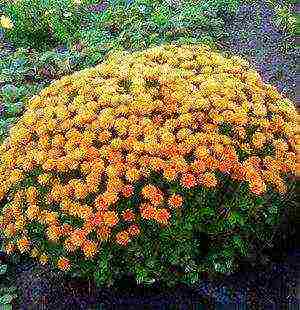 According to the shape and height of the bush, garden chrysanthemums are divided into three types, each of which has many varieties.
According to the shape and height of the bush, garden chrysanthemums are divided into three types, each of which has many varieties.
Tall. The stems of this type of garden chrysanthemum can be very tall and require supports such as frames, metal nets, or wooden pegs. Supports are installed during the planting of the bushes. Plants planted in a group can be used as a hedge. Most popular varieties tall garden chrysanthemums are:
- "Amber Lady" - the plant is distinguished by golden inflorescences.
- "Umka" - chrysanthemums with white flowers, the shape of which resembles a pompom.
- "Daughter of Rosetta" is strewn with flat inflorescences with flowers of pink and white shades.
Medium-sized. Bushes growing up to 30-50 cm look very impressive both on a flower bed and along paths, fences, arbors. With their help, you can realize various design fantasies. The best varieties of medium-sized garden chrysanthemums are considered:
- "Dawn" - the plant has a yellow-brown color, which is just right for the autumn mood.
- "Dune" is a truly magical variety, the flowers of which can change their color during flowering. They bloom yellow-brown, and after a few days they turn yellow-gold.
- "Lily" will help to add brightness to any composition with its dark crimson flowers.
Curb. Small plants grow up to only 30 cm. This type of chrysanthemum is considered one of the most beautiful garden flowers. Bushes of curb chrysanthemums have the shape of a ballcovered with small flowers. In this group, the most popular varieties:
- "Barbara" is a plant with delicate lilac-purple flowers.
- "Evening Lights" - the variety is distinguished by scarlet inflorescences that resemble a festive fireworks.
- "Talisman" is strewn with bright beetroot-crimson flowers.
Flower shape
Garden chrysanthemums have five different kinds of flower shapes:
-
 Pompom flowers are an assembly of tongues that are assembled into a ball that resembles a pompom.
Pompom flowers are an assembly of tongues that are assembled into a ball that resembles a pompom. - Anemoid flowers consist of large petals, which are collected in one, two or three rows. The flowers themselves are small in size and very similar to anemone flowers.
- Single-row and double-row inflorescences are bordered by flowers that look like tongues. In the center of such inflorescences, small tubular flowers grow. The border of flowers can be arranged in one or two rows.
- Semi-double flowers consist of three rows of reeds that are arranged around a central flower.
- Terry inflorescences are similar to semi-double ones, but their flowers are more luxuriant, since they are diverse in appearance and shape.
Garden chrysanthemums - planting and care
It is recommended to plant a plant during the period from late May to mid-June... Until autumn, the bushes will have time to take root and get stronger. And then they will not be afraid of any winter frosts.
Landing features
Chrysanthemums love sunny areas. The plant requires a lot of light to set flower buds. Even in partial shade, chrysanthemums will not bloom.
The soil must be rich in organic matter.Therefore, during digging, one bucket of manure, compost or peat must be added to one square meter of soil. You don't need to add more organic matter, otherwise only leaves will grow rapidly on the bush, and the plant will bloom with very small flowers.
When planting a garden chrysanthemum, it is recommended:
-
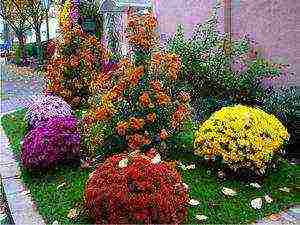 For large bushes, the distance between the holes should be at least 50 cm, and for small bushes - 25 cm.
For large bushes, the distance between the holes should be at least 50 cm, and for small bushes - 25 cm. - It is recommended to add drainage or sand to each hole.
- When planting, the plant cannot be deeply deepened into the ground.
- Near large, tall bushes, you must immediately install a support.
- The leaves of the plant can be sprayed with Epin to help it adapt better. "Kornevin" is also suitable, with a solution of which the bush is watered.
- If frosts are still expected, then the young bush should be covered with nonwoven material at night.
Care rules
When caring for a garden chrysanthemum, special attention should be paid to watering it, since the plant depends on soil moisture level... You need to water the bushes in a timely manner, otherwise the flower will throw off all the buds.
The amount of water for watering one bush depends on its characteristics. Plants with small, stiff leaves can be watered less frequently than plants with soft, large leaves that evaporate a lot of moisture.
Chrysanthemums respond well to feeding. For this, complex mineral fertilizers containing magnesium and potassium, and organic in the form of humates are used. During the active growth of green mass, the plant is fed with nitrogen.
Caring for garden chrysanthemums involves forming a bush. It is necessary regularly pinch and trim... For the first time, the top of the plant is removed when the central shoot grows to 10 cm. After a while, when the lateral shoots grow up to 10 cm, they also pinch the crown. After that, the bush grows to bloom.
During the period when the chrysanthemum blooms, faded and wilted buds should be regularly removed from its bush. This way the flowering period can be extended.
If you want to get big beautiful flowers, you can make a total pruning of side shoots. As a result, only one stalk and one peduncle will remain on the bush. All the forces of the plant will go to the formation and growth of the flower.
Winter garden chrysanthemum care
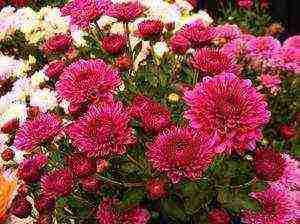 In order for a plant planted in the garden to bloom as beautifully and profusely next year, you need to make sure that it overwinters well.
In order for a plant planted in the garden to bloom as beautifully and profusely next year, you need to make sure that it overwinters well.
In frosty winters even cold-resistant varieties require shelter... Therefore, after the end of flowering, the stems of the bushes are cut to the ground. The plant hides and covers itself with fallen leaves.
Chrysanthemums with large flowers are afraid of freezing temperatures. Therefore, they need to be dug out together with an earthen lump and planted in a suitable container. Plants are stored before planting in the spring in a room with a temperature of 0-5 degrees. Caring for them consists in rarely watering an earthen coma, which should not dry out.
Diseases and pests of perennial chrysanthemums
With proper care, the plant is rarely affected by pests and practically does not get sick. However, the bushes need to be inspected regularly in order to identify the problem as soon as possible and begin to treat the plant. The threat to garden chrysanthemums is posed by:
- Spider mite is a pest that sucks juice from a plant. It can be found by the cobweb formations on the back of the sheet. If the leaves of a chrysanthemum become gray-brown, begin to darken and fall off, then, most likely, a tick has settled on it. The plant must be treated with special chemicals.
- Leaf nematodes - the disease is manifested by deformation of the leaves, and their darkening between the veins. In this case, you need to change the soil and cut off the damaged areas.
- Verticillosis is an infectious disease that spreads through the roots. Therefore, the leaves begin to turn yellow and wither from the bottom of the bush. In the initial stages, spraying with biological products will help.
- Powdery mildew first affects the leaves and buds, on which a white bloom appears. The affected parts of the plant are removed, and the bush itself is treated with Bordeaux liquid.
Reproduction of bush chrysanthemum
Chrysanthemum can propagate in three ways:
- dividing the bush;
- seeds;
- by cuttings.
Dividing the bush
The bushes can be divided in the spring, but only after the threat of frost has passed. In order for chrysanthemums to bloom better, it is recommended to divide their bushes every three years. To do this, the plant is carefully dug up and divided into several small bushes. The roots of the plant will need to be cut. Delenki are planted in the ground and watered.
Seed reproduction
In open ground sowing is done in May... For each future plant, a separate hole is dug, the distance between which should be 25 cm. 3-4 seeds are buried in one hole. For the first time, chrysanthemums should bloom at the end of summer.
Cuttings
 Propagation by cuttings is the easiest way, since chrysanthemums take root quickly and well.
Propagation by cuttings is the easiest way, since chrysanthemums take root quickly and well.
- A stalk with 3-4 leaves is cut under a leaf pattern. Its length should be 6-8 cm.
- The container is filled first with peat, and then with sand, into which the stalk sits.
- The soil is sprayed and the box is covered with glass.
The rooting temperature should be between 13-15 degrees. When the roots appear, the cuttings will need transplant into separate pots... Young bushes are planted in open ground only when frost has passed.
Observing the rules of planting and caring for garden chrysanthemums, you can achieve a beautiful and spectacular flowering during half of summer and almost all of autumn. Any part of the garden where the "Queen of Autumn" will grow will become a luxurious decoration of the garden.
Bush chrysanthemum
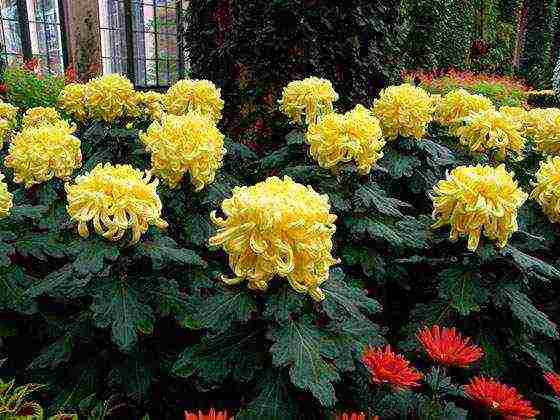
For a long time, chrysanthemums have attracted increased attention and delighted people. It is the leading flower crop for the withering autumn garden. A huge number of different varieties of chrysanthemums allows you to choose a plant for every taste.
Large chrysanthemums are especially good at cutting and are used to create colorful autumn compositions. Their huge multi-colored flowers on tall strong stems keep freshness in a vase for a long time. The late bloom and excellent decorative properties make these majestic flowers especially popular.
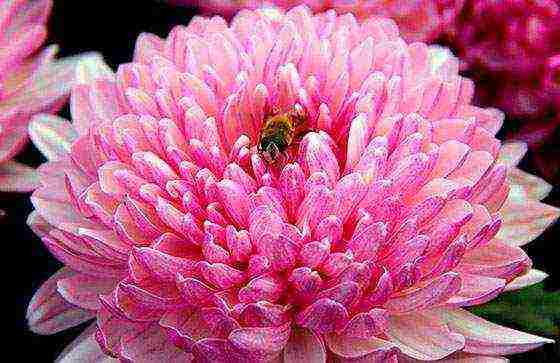
Chrysanthemums with small flowers usually finish flowering when the heavy frost sets in in October. And large-flowered chrysanthemums in greenhouses are not afraid of cold weather and continue to delight us with their beauty and bright colors. But not all of our readers have greenhouses, so they are interested in whether it is possible to grow large-flowered chrysanthemums in the open field in the middle lane and even in Siberia.
Yes it is possible. We will tell you how to do this in this article.
- Video: How to grow large-flowered chrysanthemums
- Planting large-flowered chrysanthemums in the garden
- Caring for large-flowered chrysanthemums
- Chrysanthemum protection in autumn
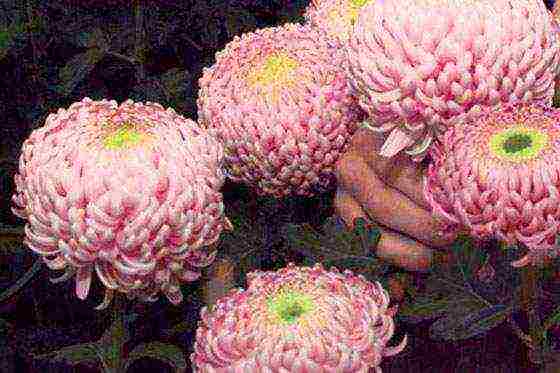
Video: How to grow large-flowered chrysanthemums
Planting large-flowered chrysanthemums in the garden
Large-flowered chrysanthemums can be planted outdoors before they bloom. They need to be planted so that then the plants can be covered with foil and frames. This will allow you to grow gorgeous large chrysanthemums without replanting.
Transplanting negatively affects the quality of the flowers. Flowers from transplanted plants are 2-3 times less in a vase than flowers from non-transplanted bushes.
You can also plant chrysanthemums in large pots that dig completely into the soil in the garden. And in September, before the onset of frost, the pots are removed from the ground and transferred to a greenhouse or other room. At the same time, the root system of plants is not disturbed, so they bloom profusely and stand for longer in the cut.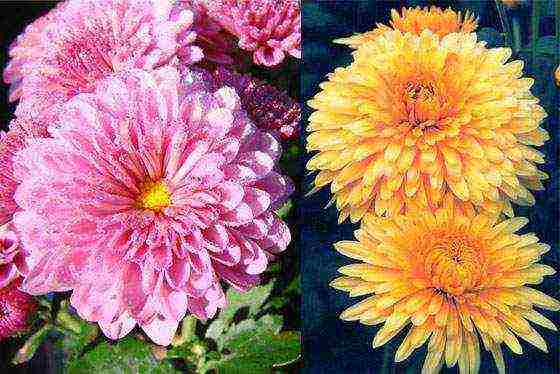
Outdoor care for large-flowered chrysanthemums
In order to get beautiful large chrysanthemum flowers in the fall, in the summer, during their active growth, it is necessary to provide them with proper care, regular watering and feeding. In the beginning, young plants are often watered, being careful not to wet the leaves.
One of the most important nutrients for the development of large-flowered chrysanthemums is nitrogen. It significantly affects the height of the bush, the size and color of inflorescences and leaves. The more nitrogen in the soil, the taller and larger the plants will be, and the more intense the color.
However, a balance must be struck with other nutrients, especially phosphorus. Phosphorus accelerates flowering and increases disease resistance.
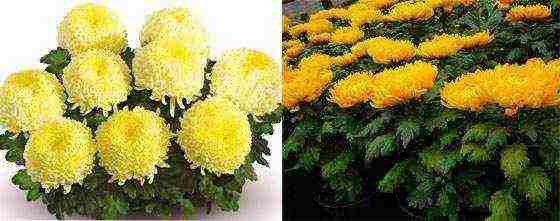
It is useful to feed chrysanthemums with natural organic fertilizers: mullein infusion, chicken droppings, vermicompost infusion or fermented grass.
Regularly inspect large-flowered chrysanthemums, remove dead leaves, as they can be affected by diseases and pests.
Cuttings planted in late April and May are grown without pinching. And plants planted in early spring or winter are pinched to avoid blooming too early. The first pinching is carried out after rooting at a height of 15 cm, the second - upon reaching 25 cm.
To obtain highly decorative large chrysanthemums, pinching and pinching are used - side shoots and buds are removed. Usually one shoot and one main bud are left.
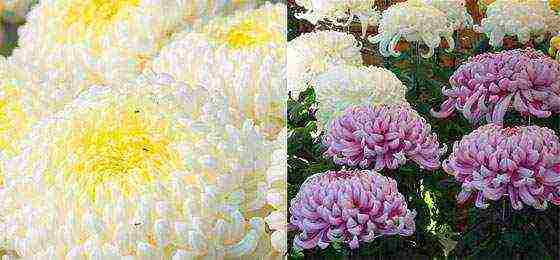
Chrysanthemum protection in autumn
In autumn, large-flowered chrysanthemums should be covered with foil. It is also better to stretch the fabric under the film to protect against dripping condensation, which can spoil the decorative effect of some varieties. Water the plants in the greenhouse abundantly, avoiding water getting on the leaves.
Large-flowered Indian chrysanthemums cannot winter outdoors in the harsh northern regions. Therefore, for the winter, the mother liquors need to be dug up and removed to storage.
After cutting the flowers, their mother liquors are cut off, leaving shoots 10 cm long. The plants are dug up and placed in deep boxes. The top of the box is sprinkled with wet peat and sand in equal proportions so that only the tops of the layers are visible.

The boxes can be left in the greenhouse or on the veranda until the cold weather, then when the soil dries up, they are removed for storage. A dark room with a temperature of about -1 to +5 degrees is suitable.
Klabukova Tatiana
author Nedyalkov S.F., photo by the author
Chrysanthemums are considered favorites of the withering autumn garden and are the leading flower culture of the late autumn and early winter periods. A large number of bred varieties of chrysanthemums allow you to choose plants for every taste.
Many flower growers around the world classify chrysanthemums as "hobby" plants and collect collections of these wonderful plants. They are especially sensitive to the culture of chrysanthemums in Japan. In Japanese culture, the art of making dolls from living chrysanthemums was even born.
Unpretentious garden chrysanthemums with small flowers usually finish flowering in October - with the onset of significant frosts. And large-flowered chrysanthemums under the cover of a greenhouse are not afraid of bad weather - they continue to delight with their beauty and freshness for a long time.
Large-flowered chrysanthemums are good for cutting, they are widely used for composing autumn compositions. Huge flowers of various colors, beautiful foliage on strong tall stems, long-term preservation of freshness in a vase, a combination of high decorativeness of large-flowered chrysanthemums with late flowering - components of the constant and widespread popularity of these majestic and at the same time graceful plants.
Watering and feeding large-flowered chrysanthemums
During the period of active summer growth of chrysanthemums in order to obtain full-fledged flowers in the fall, the main task of caring for plants is watering andtimely provision of essential nutrients.
At the beginning of the growth of young chrysanthemums, they must be watered often, while the root system is not powerful enough. When watering chrysanthemums, I try not to wet the leaves.
The most important nutrient for the growth and development of beautiful chrysanthemums is nitrogen, which affects the height of plants, the color and size of their leaves and inflorescences. With increasing doses of nitrogen application to the soil, the height of chrysanthemums, the size of their leaves and the length of the petals, the diameter and doubleness of the inflorescences increase. Also, the color of the leaves and inflorescences of chrysanthemums fed with nitrogen becomes more intense, and the plants in general are more decorative. However, the positive effect of nitrogen on the development of chrysanthemums is observed only with its optimal ratio with other nutrients (mainly phosphorus).
With a lack of nitrogen, chrysanthemum bushes form weak, with pale green leaves and small irregular inflorescences; they bloom with a strong delay. With a lack of nitrogen in the soil, this nutrient is used by plants again (that is, the upper growing part of the shoots "takes" nitrogen from the lower part of the plant). Then the lightened lower leaves on the shoots of chrysanthemums indicate a lack of nitrogen in the substrate.
Excess nitrogen also affects plants negatively: chrysanthemums grow weak, their leaves become dark green, juicy and fragile; over-fertilized plants bloom too late.
Nitrogen is characterized by a narrow range of optimal doses, therefore, I must reintroduce it in the form of several additional dressings (especially during the main vegetative growth of chrysanthemums).
It is best to feed chrysanthemums with natural organic fertilizers: chicken droppings, fermented grass, mullein infusion, vermicompost infusion, etc.
The positive effect of nitrogen on chrysanthemums is manifested only with a sufficient amount of phosphorus, which is especially important during the period of inflorescence formation. Phosphorus accelerates the flowering of chrysanthemums and increases plant resistance to diseases. With a lack of phosphorus, there is a strong delay in the growth and development of chrysanthemum bushes: plants bloom late, have small inflorescences; the leaves become small, acquire a light green color, and lose their elasticity. In the case of a severe lack of phosphorus, the lower leaves of the shoots dry out.
Caring for large-flowered chrysanthemums
During regular plant inspections dead leaves on chrysanthemum bushes must be removed in a timely manner, since they are primarily affected by pests and diseases. It mainly affects chrysanthemums with aphids (most often - the so-called "bloody" aphids). Sometimes Indian chrysanthemums in the garden are annoyed by sparrows.
Large-flowered chrysanthemums, propagated by cuttings in the second half of April and in May, I grow without pinching. And if the cuttings of chrysanthemums were planted early (in winter and early spring, in February-March), then I pinch such plants to avoid premature flowering. Each pinch delays the flowering of chrysanthemums for 2-3 weeks.
For the varieties of chrysanthemums "Gazelle" and "V. Tereshkova ”I do the pinching no more than two times. The first time I pinch a young plant after rooting, at a height of about 15 cm. The second time I pinch a plant shoot when it reaches a height of 25 cm. I then use the cut tops of chrysanthemum shoots for reproduction.
In developing large-flowered chrysanthemums, I usually leave one shoot and one central bud in order to obtain highly decorative, large inflorescences. Sometimes I leave 2-3 shoots on a powerful bush (in this case, smaller inflorescences are formed on them).
The main way to obtain large chrysanthemum inflorescences is the timely removal of emerging lateral shoots and buds - pinching and pinching... If they are removed late, the main peduncle in the upper part of the shoot grows thin, and the inflorescence becomes smaller, which reduces the decorative effect of the plant.
I remove the lateral buds of large-flowered chrysanthemums carefully and as early as possible (as soon as possible, grab the lateral buds with your fingers, so as not to damage the remaining main bud).
Since plants of the same variety often develop unevenly, their buds are not formed simultaneously, with a difference of 10-15 days. Therefore, during the budding period, in order to timely remove the lateral buds, it is necessary to check the condition of the chrysanthemums several times, every 3-4 days.
Planting and transplanting large-flowered chrysanthemums
Large-flowered chrysanthemums of the Gazelle and V. Tereshkova "I grow in the open field until they bloom. Therefore, I plant the plants in the garden in such a way that later blooming chrysanthemums can be covered with a film or frames from the weather. This allows you to get a high-quality cut of chrysanthemums directly from the open field, without replanting plants.
Transplantation of chrysanthemum bushes of the Gazelle variety noticeably affects the quality of the inflorescences. In addition, flowers from transplanted bushes cost 2-3 times less in cut than inflorescences from non-transplanted bushes.
Sometimes I plant chrysanthemums in large pots, which I dig completely into the soil of the garden. In August, I remove the pots with plants from the ground and transfer them to a room or a greenhouse. At the same time, the root system of potted chrysanthemums is not disturbed, they bloom and stand in the cut for much longer than "soil" plants.
Protecting large-flowered chrysanthemums in autumn
When I cover the large-flowered chrysanthemums blooming in the garden with a film in the fall from bad weather, I must also stretch the fabric over the plants (for this purpose, you can use a covering material of any brand). Otherwise, during the wind, when the film "flaps" under its gusts, then drops of condensate flying off the film will fall on the chrysanthemums. Large snow-white flowers of Gazelle chrysanthemums quickly lose their decorative effect and decay from water droplets hitting them, but Valentina Tereshkova chrysanthemums are not so afraid of dripping moisture.
At temperatures below +3 degrees, Gazelle chrysanthemums produce poor flower baskets, and the flowers begin to turn black. Therefore, I warm up the foil greenhouse with chrysanthemums in the freeze.
I water chrysanthemums abundantly in the greenhouse, but at the same time I try to keep the water out of the leaves.
Wintering of large-flowered chrysanthemums
Indian large-flowered chrysanthemums do not hibernate in the open field of regions with a cold climate, since they cannot withstand a long frosty winter. Therefore, you need to take care of their wintering: in the fall, the mother plants of large-flowered chrysanthemums have to be dug up and brought into storage for winter preservation.
If in the southern part of Belarus it is possible to leave large-flowered chrysanthemums for wintering in the open ground (but only with a very careful dry shelter), then in the central and northern parts of the republic it is very risky to do this. In the fall, I dig up the queen cells of chrysanthemums and store them in the winter at a positive temperature.
In order to preserve the existing highly decorative large-flowered chrysanthemums for further cultivation, I select the best plants during their flowering for mother plants.
High-quality mother plants have large flowers of the correct shape, beautiful leaves and a healthy look of the bushes in general; full-fledged plants form many strong cuttings.
The most valuable thing in the queen cells of chrysanthemums is the layers that have grown during the flowering of plants. ... In the future, these layers will be used for propagation of chrysanthemums by cuttings.
Winter storage of large-flowered chrysanthemums is the most crucial moment of their cultivation, which requires very precise implementation of these instructions.
After cutting the flowers, I cut off the queen cells of chrysanthemums, leaving the lower part of the shoots up to 10 cm long. I dig out the plants and very tightly put the rhizomes in deep boxes.From above I pour into the box a slightly wet mixture of peat and sand in equal proportions (so that only the tops of the layers remain at the top).
I leave boxes with queen cells of chrysanthemums in the greenhouse or on the veranda until the cold, do not water. I put the plants for storage only after the soil in the box with mother liquors dries out significantly (the drier, the better).
Any room without constant lighting, with a temperature from -1 to +5 degrees, is suitable as a repository for large-flowered chrysanthemums. At this temperature, the rhizomes of chrysanthemums are preserved for sure, the plants do not start growing. Under such conditions, old roots of chrysanthemums do not take root during wintering, valuable cuttings are well preserved.
In winter, I do not water the queen cells of stored chrysanthemums in any case. If during the winter storage of the mother plants of chrysanthemums, the tops of their layers were eaten by rodents that managed to penetrate the storehouse (mice, rats), then there is no need to worry about damaged layers. They will not die from this, just then in the future the need to pinch the tops of the layers of chrysanthemums disappears.
Nedyalkov Stefan Fedorovich (Novopolotsk, Republic of Belarus) skyrider@tut.by
"Floriculture: Pleasure and Benefit"
All about chrysanthemum on the site
Flowers Olga Ravilova
|
2017-06-14 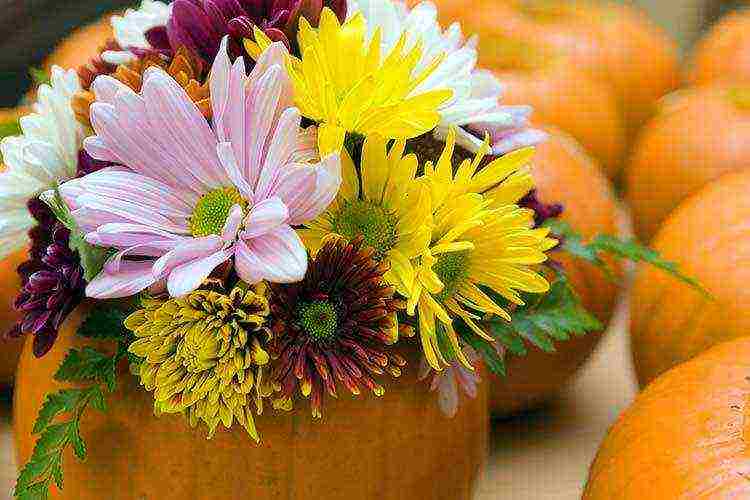 Chrysanthemums are beautiful in any setting. Photo: Robin Carlson
Chrysanthemums are beautiful in any setting. Photo: Robin Carlson
Chrysanthemums are popular ornamental plants that bloom from August to November. Chrysanthemums give the autumn garden a special charm, when most of the flowers have already gone to the autumn-winter rest.
Chrysanthemums belong to the Astrovye family. Like asters, chrysanthemum is a perennial plant whose stem stiffens by the end of the season, becoming tough. The most common are Indian and Chinese chrysanthemums. Most varieties of chrysanthemums come from Indian chrysanthemums.
Of course, in our country, chrysanthemum grows as a summer plant, grown in seedlings in the garden, or in pots and greenhouses, as a houseplant. The warm climate of hot countries makes it possible to propagate chrysanthemums by simply dividing the bush, which means that most of the theses of the article are irrelevant for flower growers in Asia and the Far East.
Decorativeness is the fad of chrysanthemum, as well as flowering in autumn. Yes, the vast majority of varieties bloom in October-November.
Chrysanthemum varieties are usually divided into two large groups: large-flowered and small-flowered. More than 1000 varieties of large-flowered chrysanthemums are known, they inspire flower growers more than chrysanthemums with small flowers.
 Large-flowered chrysanthemums are more popular than small-flowered ones. Photo: Presbyterian Senior Care
Large-flowered chrysanthemums are more popular than small-flowered ones. Photo: Presbyterian Senior Care
Basically, chrysanthemums are subdivided by the signs of the structure of inflorescences:
- Anemoid chrysanthemums;
- Decorative chrysanthemums;
- Chinese chrysanthemums;
- Single, simple chrysanthemums;
- Peony chrysanthemums;
- Pompom chrysanthemums;
- Tubular chrysanthemums;
- Japanese chrysanthemums.
Single chrysanthemums have flowers with non-double inflorescences, and the rest are double.
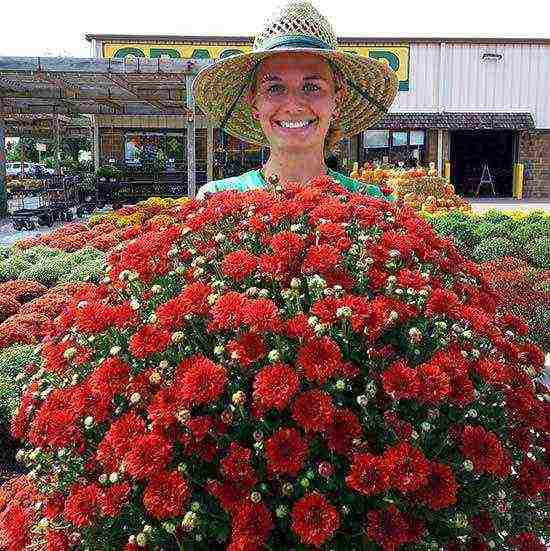 Chrysanthemums are a suitable material for landscape design
Chrysanthemums are a suitable material for landscape design
Varieties of large-flowered chrysanthemums with white, pink, lilac, yellow, golden and bronze flowers are popular. Moreover, large-flowered chrysanthemums are grown in one stem, and small-flowered chrysanthemums are in the form of a bush or in a standard form.
 Chrysanthemums even have decorative buds.
Chrysanthemums even have decorative buds.
Small-flowered chrysanthemums derived from Chinese varieties are suitable for growing in the open field garden, as it is hardy enough to endure the winter.
Reproduction of chrysanthemums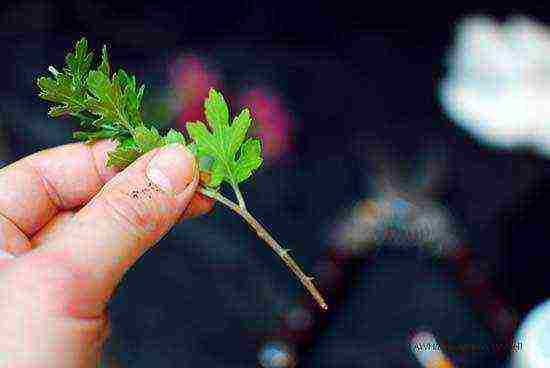 Chrysanthemums are propagated by cuttings. Photo: MissingHenryMitchell
Chrysanthemums are propagated by cuttings. Photo: MissingHenryMitchell
To preserve all the hereditary characteristics of the parent plants, chrysanthemums are propagated vegetatively - by herbaceous cuttings.
Cuttings are cut from uterine chrysanthemums in February - March. Mother plants should overwinter at a temperature of +5 - 7 ° C. Healthy plants are selected for wintering, cutting off the stems at a height of 10-15 cm.Mothers overwinter in containers or pots of suitable size. During wintering, the soil must be moistened occasionally.
Chrysanthemum cuttings continue until May, as the offspring grow on the queen cells. However, green cuttings of large-flowered varieties of chrysanthemums complete 20 April.
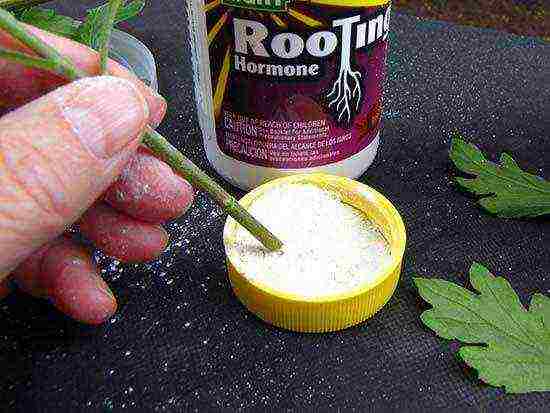 Before rooting, it is advisable to treat the slices of chrysanthemum cuttings with a growth stimulant. Photo: Views from the Garden
Before rooting, it is advisable to treat the slices of chrysanthemum cuttings with a growth stimulant. Photo: Views from the Garden
The cuttings are rooted in a peat-sand mixture or in sand, at a temperature of +12 - 14 ° C, for two to three weeks. When the chrysanthemum cuttings take root, they are transplanted into pots without drainage. The diameter of the pots is 7 cm. The soil should be light - a mixture of humus and turf in equal proportions. The pots are placed in a bright, cool place.
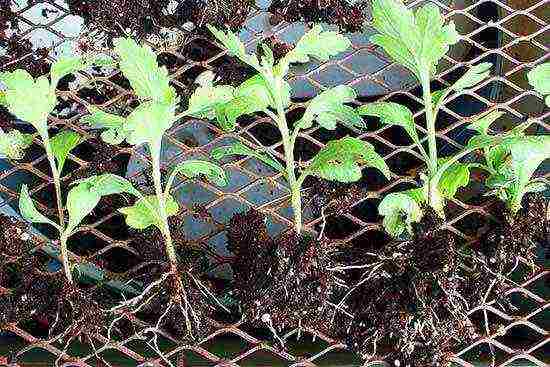 Chrysanthemum cuttings take root in 2-3 weeks
Chrysanthemum cuttings take root in 2-3 weeks
The transfer of large-flowered chrysanthemums is done in May, in pots with drainage, with a diameter of 11 cm. A mixture of humus and sod land (1: 2), with the addition of shavings, is favorable for chrysanthemums during this period. Small-flowered chrysanthemums do not pass, leaving them in small pots before planting in open ground.
Planting large-flowered chrysanthemums in open ground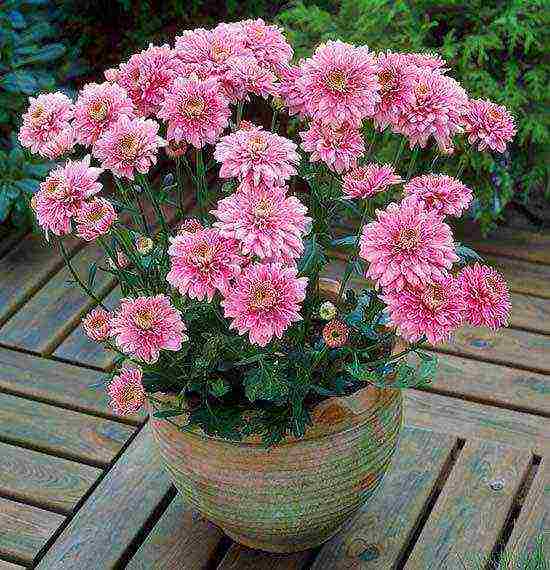 Large-flowered chrysanthemums are planted in open ground directly in pots. Photo: Fresh Design Pedia
Large-flowered chrysanthemums are planted in open ground directly in pots. Photo: Fresh Design Pedia
Large-flowered chrysanthemums are planted in open ground directly in pots, after having made a transfer into pots with a diameter of 12-14 cm, in late May - early June.
If chrysanthemums are intended for cutting into bouquets, then you can plant them in open ground without pots, tying the stems to pegs about a meter long. The length of the peg is adjusted depending on the variety.
It is advisable to plant chrysanthemums in ridges, in four rows, with a row spacing of 25 cm. The pots are installed in recesses so that the edges are flush with the ground.
Chrysanthemum care
Caring for chrysanthemums is simple: watering, loosening, weeding, feeding and pinching:
- Chrysanthemums watered dailyif there is no rain. It is advisable to spray the plants with soft water, humidifying the air. It is not worth overmoistening the soil - chrysanthemums wither from excess water, leaves turn yellow, inflorescences wrinkle and develop poorly.
- Chrysanthemum feeding is performed two or three times per season... Use mineral fertilizers for flowers or slurry, depending on availability. They are fed in the form of fertilizing irrigation, under the root.
- Weeding necessary both between plants and directly in pots. In parallel with weeding, the soil is loosened in the aisles and in pots.
- Chrysanthemums desirable tie to pegsas you grow.
- Plants are regularly inspected for pests. Aphids and spider mites, without pity, are destroyed with drugs - insecticides.
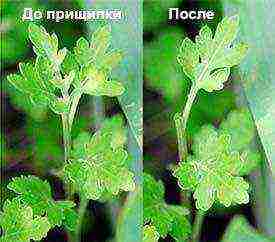 Pinching the side shoots helps shape the plantChrysanthemum grazing - a responsible operation for the care of plants, performed in June - August. Axillary shoots and lateral buds, near the apical flower bud, are removed with scissors or a sharp knife. The first apical bud is removed in all cases before the first transfer, and the strongest of the new developing shoots is left. The axillary shoots are broken out or cut out with a sharp knife, and the buds growing adjacent to the apical flower bud are removed with a sharp stick.
Pinching the side shoots helps shape the plantChrysanthemum grazing - a responsible operation for the care of plants, performed in June - August. Axillary shoots and lateral buds, near the apical flower bud, are removed with scissors or a sharp knife. The first apical bud is removed in all cases before the first transfer, and the strongest of the new developing shoots is left. The axillary shoots are broken out or cut out with a sharp knife, and the buds growing adjacent to the apical flower bud are removed with a sharp stick.
Back to the greenhouses
As the buds of chrysanthemums develop, when they begin to acquire color, the plants are transferred to greenhouses or greenhouses. Pots, before entering the greenhouse, are cleaned of soil, and plants from dried leaves.
Chrysanthemums of late varieties are transferred to greenhouses in September, due to autumn matinees, with unopened buds.
Greenhouses and greenhouses should be light and well ventilated to ensure abundant flowering. Moisture trapped in the opening buds of chrysanthemums in cold weather, both in open and closed ground, leads to decay.
Dampness and drops in greenhouses are also harmful to chrysanthemum buds, so the buds do their best to prevent moisture from entering.
If autumn is early, and the buds are poorly developed, the plants are installed in deep cleaned greenhouses, covering them with frames. During the day, greenhouses are well ventilated, and on warm days, the frames are removed.
Growing small-flowered chrysanthemums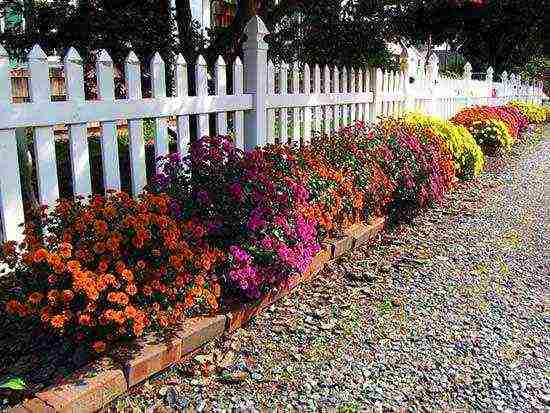 Small-flowered chrysanthemums will decorate any fence
Small-flowered chrysanthemums will decorate any fence
Small-flowered chrysanthemums are planted in open ground at the end of May. The distance between plants is 40 - 50 cm.
Caring for small-flowered chrysanthemums is similar to caring for large-flowered plants, with the exception of pinching and a garter to the pegs.
It is advisable to pinch the shoots once or twice a summer so that the plants branch out better. In the second half of August, as soon as a sufficient number of buds are formed, the plants are planted in 16-18 cm pots and set in deep greenhouses.
In the process of growing chrysanthemums, you have to protect them from pests and diseases. Chrysanthemums are harmed by: thrips, green and black aphids, nematodes. Chrysanthemums are sick with rust and powdery mildew. The greatest damage to chrysanthemums is caused by nematodes.
If nematodes attacked your chrysanthemums, then only quarantine and thorough disinfection of pots and growing areas: ridges, greenhouses, hotbeds, etc. will save you. The rest of the pests and diseases are eliminated in the working order.
Small-flowered chrysanthemums are planted in open ground at the end of May. The distance between plants is 40 - 50 cm.
Caring for small-flowered chrysanthemums is similar to caring for large-flowered plants, with the exception of pinching and a garter to the pegs.
It is advisable to pinch the shoots once or twice a summer so that the plants branch out better. In the second half of August, as soon as a sufficient number of buds are formed, the plants are planted in 16-18 cm pots and set in deep greenhouses.
In the process of growing chrysanthemums, you have to protect them from pests and diseases. Chrysanthemums are harmed by: thrips, green and black aphids, nematodes. Chrysanthemums are sick with rust and powdery mildew. The greatest damage to chrysanthemums is caused by nematodes.
If nematodes attacked your chrysanthemums, then only quarantine and thorough disinfection of pots and growing areas: ridges, greenhouses, hotbeds, etc. will save you. The rest of the pests and diseases are eliminated in the working order.
We have a special relationship with chrysanthemum, this is the flower that is always nice to remember! To get compact flowering bushes, garden chrysanthemums need to be well cared for, planted, watered and fed on time, properly shaped, divided and cuttings.
Features of growing perennial garden chrysanthemums (small-flowered), planting and care ...
Without going into the details of the classification, we will divide all chrysanthemums conditionally into two types:
- Large-flowered Indian, flowers that we often see in beautiful bouquets, they can be grown if you live somewhere in the southern regions, or you have a greenhouse or greenhouse.
- Shrub varieties, small-flowered, very beautiful and compact-looking chrysanthemums - we especially highlight the group of Korean hybrids (Chrysanthémum × koreanum), most often grown in the middle lane.
Most gardeners only grow cold-resistant chrysanthemums, which we used to call Korean (oak, oak). Their origin is hybrid, there are many varieties and they are very diverse in color, size and shape. The chrysanthemum will delight all season if not with flowers, then with its crown, foliage, and a beautiful ball. And they bloom until late autumn, depending on the variety - 20-60 days.
Among small-flowered bush chrysanthemums, flowers can be double: flat, hemispherical, spherical, pompom, curly; as well as simple (chamomile): non-double, semi-double, anemone.
In terms of landscape design, chrysanthemum is a very interesting flowering plant.She is one of the first to appear in the spring, the flower itself, of course, blooms in the fall, but its foliage is small, so carved, slightly silvery in color, looks great in any color combinations, in harmony with many garden plants.
Can chrysanthemums be planted in autumn?
Most experts in this field believe that the autumn planting of perennial chrysanthemums should be carried out only in warm regions, giving preference for this to small-flowered varieties. In addition, this is the most common time when planting material is sold in the markets. Florists have the opportunity to evaluate the bush, its height, size and color of the inflorescences. If you buy chrysanthemums for planting in the spring, it remains to follow at random, since it is quite difficult to predict anything by looking at the still bare branches.
It is better to buy early flowering chrysanthemums no later than September, besides, the plant should be blooming profusely.
Flowering seedlings are typically sold by cut flower growers and late flowering varieties are often grown in their greenhouses to prolong flowering. The next fall, the chrysanthemum does not have time to bloom in our gardens, because of the frost, all the long-awaited beauty disappears.
A worthy option is to buy a flowering bush in a pot in the fall, wait until the end of flowering, break off the dry stems and leave for the winter in a dry, cold basement at a temperature of 4-5 degrees Celsius. In the spring, plant chrysanthemums in open ground. The conditions for proper winter storage are described below.
Some tips for planting chrysanthemums in the fall:
- The optimal time for planting is considered the end of September - the first half of October;
- You should not plant flowering bushes - there is a great risk that they will not take root;
- For planting, it is better to choose bushes on which root shoots have formed.
- Before frost, planted chrysanthemums must have time to get stronger in order to endure the winter frosts well.
- Do not forget to mulch the soil with a layer of peat or compost, and before frost in November, it is better to cover it with something to protect it from the cold.
Choosing a place for planting chrysanthemums.
First of all, it should be an open, well-ventilated and sunlit place. There should be no constant wind and draft, at the same time there should be no stagnation of air.
It cannot be planted in lowlands so that the root system is not flooded with water. It is advisable to plant on small hillocks so that in case of heavy rainfall, the water goes down and does not stagnate in the roots.
If you want to plant chrysanthemums in sandy soil, fill with good compost, humus, as it loves fertile soil. A bush on too fertile soil can grow to the detriment of flowering.
We will plant bush chrysanthemums ...
You have purchased neat bushes of small-flowered chrysanthemums in garden centers or from private owners, or they have already been growing in the garden for more than one year and need to be planted. You can simply divide the roots into parts and plant each one separately. The plant takes root well and you will have several bushes. Before digging up the bush, water it to saturate them with moisture.
We prepared the site in advance, divided it into grooves. The distance between the holes is small, almost close, so that between the bushes it turns out 35-40 cm, small border compact bushes can be planted denser - 20-25 cm. It is advisable to add some kind of organic fertilizer or compost to each hole. Since the roots of a young plant are still weak, mineral fertilizers are not poured into the planting hole, otherwise we risk "burning" the roots.
In early spring, 1 time in 3 years, multiple shoots should be planted. We dig out the whole mulched bush when the regrown shoots reach a height of 5-7 cm.
We take a bush, shake off the ground and begin to simply break it in half. Then we separate the neat well-developed sprouts with roots one by one.If a sprout is left without a root, then it can be rooted like a cutting in damp ground. The sprouts can be small, medium or large, depending on the parent shrub we choose to plant. Fill the holes with water and, like any seedlings, plant chrysanthemum plants.
How the bush is formed correctly ...
The pinching procedure is one of the important points in the care of garden chrysanthemums. If we pinch correctly, then a chic bush can turn out from a small sprout.
Before planting the root, in large sprouts with leaves in several tiers, pinch the top so that the plant has 5-6 true leaves, not counting the stepsons. By removing the growth point, we thus stimulate the development of lateral shoots of the second order. If this is not done, the sprout will grow up, stepchildren will begin to appear, but not so powerful, the bush will not be so compact and not so abundant.
For curbs, re-pinching will not work, it will simply grow in such a round ball, and for those chrysanthemums that are taller, you will have to pinch again on second-order shoots, leaving 3-4 leaves.
Caring for chrysanthemum in the garden
Chrysanthemum is not a plant for the lazy and requires constant care, including planting. As already mentioned, the bush is regularly pinched to increase bushiness due to the growth of lateral shoots.
In June-July, be sure to water chrysanthemums abundantly, especially when the first buds appear. In no case do not sprinkle its crown, watering should be only under the root system. In August, watering can be stopped - the flowering period begins. Reacts well to a decrease in night temperature.
Top dressing is done in spring and summer, once every 2 weeks with mineral and organic fertilizers. At the beginning of growing young chrysanthemums, it is better to use nitrogen fertilizers to build up the green mass, later phosphorus-potassium fertilizers for better flowering.
Loosening is carried out only in the first month after planting, so as not to damage the root system and the root shoots growing towards autumn.
Cuttings are carried out in the open field, from the end of May to September. You can bend the twigs to the ground and pin them with special wire forks, so they give roots very quickly.
In the fall, when you break off the stems, there are trimmings - cuttings already ready for planting. Better to plant in special substrates designed for rooting. Either they are dipped in water and they give roots - this is the most elementary way.
Wintering conditions for chrysanthemums in the middle lane ...
Some gardeners fear that small-flowered Korean chrysanthemums may freeze in winter. In principle, in some northern regions this happens, so in October, mulch the space under the bush, cover the root system with a thick layer of peat and compost. And already in November, not earlier, so that the plant does not become rotten, cover it on top with spruce branches left after pruning coniferous trees. It is a very good cold insulating material.
You can dig a chrysanthemum bush into some container, add earth and store it in a cold cellar. Do not forget to break off the dried stems. Digging with a shovel, you should retreat from the main stem further away, since the bush grows in a circle and gives offspring at a distance of up to 20 cm.Practice shows that chrysanthemums overwinter quite successfully at a temperature of 4-5 degrees, and in the spring they are again transferred to the ground.
You do not need to water them, otherwise the new shoots that form there will begin to grow ahead of time. Nothing good will come of this, the stems will only stretch out from a lack of light, and the roots will deplete. If the soil is too dry during storage, then you can put a couple of handfuls of snow on top of the soil, or lightly sprinkle with a moisturizer.
In no case do not put a pot or a lump of earth in a bag, this will cause condensation to accumulate and the sprouts under the film will begin to rot.
After digging, a couple of shoots from this bush may remain in the ground, we leave them in place in the garden, fill the hole with soil, mulch, cover with something and see what happens, whether they overwinter or not. And then we will know how to deal with it next year. Is it worth digging them up later, or is it better to leave them for the winter in the ground.
If you bought chrysanthemums with large flowers, white or yellow, which are sold for cutting, they are most likely Indian large-flowered varieties. In our climate, they do not hibernate at all and simply do not have time to bloom, it is not even worth experimenting. Plant them in some container and also put them in the cellar. And then large-flowered garden species of chrysanthemums have their own subtleties in growing, which must be discussed separately.


